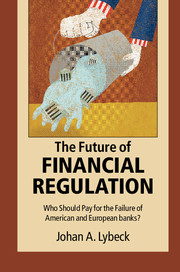Book contents
- Frontmatter
- Dedication
- Contents
- List of figures
- List of tables
- List of boxes
- Preface
- Acknowledgements
- List of abbreviations
- Introduction
- Part I A chronological presentation of crisis events January 2007 – December 2014
- Part II Bail-out and/or bail-in of banks in Europe: a country-by-country event study on those European countries which did not receive outside support
- Part III Bail-out and/or bail-in of banks in Europe: a country-by-country event study on those European countries which received IMF/EU support
- Part IV The TARP program and the bailing out (and bailing in) of US banks
- Part V Summary of the micro studies
- Part VI Political and regulatory responses to the crisis: to bail out or to bail in, that's the question
- 17 Future bail-outs in the United States under Dodd–Frank and OLA
- 18 Future bail-outs in the European Union under the Single Resolution Mechanism and the Bank Recovery and Resolution Directive
- Conclusion: toward host-country supervision and resolution?
- Addendum
- Bibliography
- Index
17 - Future bail-outs in the United States under Dodd–Frank and OLA
from Part VI - Political and regulatory responses to the crisis: to bail out or to bail in, that's the question
Published online by Cambridge University Press: 05 February 2016
- Frontmatter
- Dedication
- Contents
- List of figures
- List of tables
- List of boxes
- Preface
- Acknowledgements
- List of abbreviations
- Introduction
- Part I A chronological presentation of crisis events January 2007 – December 2014
- Part II Bail-out and/or bail-in of banks in Europe: a country-by-country event study on those European countries which did not receive outside support
- Part III Bail-out and/or bail-in of banks in Europe: a country-by-country event study on those European countries which received IMF/EU support
- Part IV The TARP program and the bailing out (and bailing in) of US banks
- Part V Summary of the micro studies
- Part VI Political and regulatory responses to the crisis: to bail out or to bail in, that's the question
- 17 Future bail-outs in the United States under Dodd–Frank and OLA
- 18 Future bail-outs in the European Union under the Single Resolution Mechanism and the Bank Recovery and Resolution Directive
- Conclusion: toward host-country supervision and resolution?
- Addendum
- Bibliography
- Index
Summary
Dodd–Frank Wall Street Reform and Consumer Protection Act of 2010: what it doesn't do
Many believe, as I do, that the Dodd–Frank Act in its present form will neither prevent a future financial crisis nor alleviate its resolution in comparison with experiences from the recent crisis. Rather it risks making it worse. A number of comments supporting this view will be stated below.
One could also note that at 848 pages, it easily surpasses the 32 pages of the Federal Reserve Act of 1913 and the 37 pages of the Glass–Steagall Act of 1933, the earlier major pieces of banking legislation. However, the Financial Institutions Reform, Recovery, and Enforcement Act (FIRREA) of 1989 ran to 371 pages, showing the rising trend. Increasing complexity is the rule of the day. However, there are also rising demands from central bankers for less complexity.
And this is only the primary legislation which must then be translated into actual rules. At latest count, only just over one half of the 398 pieces of detailed rules that must be adopted by the Federal Reserve, the SEC, the CFTC, the FDIC and the other regulators had been finalized by mid 2014, four years after President Obama's signing of the Act. The final product will run to tens of thousand pages of rules by which the financial industry must abide. It has been estimated that 2,600 new supervisors are needed. The largest US banks have hired 10,000 new compliance officers since the Dodd–Frank Act was adopted. The House of Representatives Financial Services Committee has estimated that the Dodd–Frank regime would impose at least 27 billion dollars in new assessments annually on financial firms and require more than 2.2 million annual labor hours to comply with just the first 10 percent of rules issued. As a percentage of revenue, small banks will bear costs under the new regulation that far exceed those borne by the megabanks.,
Dodd–Frank has indeed created a monster whose appetite is yet to be determined. Box 1 presents some highly relevant criticisms of the Dodd–Frank legislation, coming from lawyers as well as economists (all italics in the quotes are mine to stress the main points).
- Type
- Chapter
- Information
- The Future of Financial RegulationWho Should Pay for the Failure of American and European Banks?, pp. 397 - 436Publisher: Cambridge University PressPrint publication year: 2016



